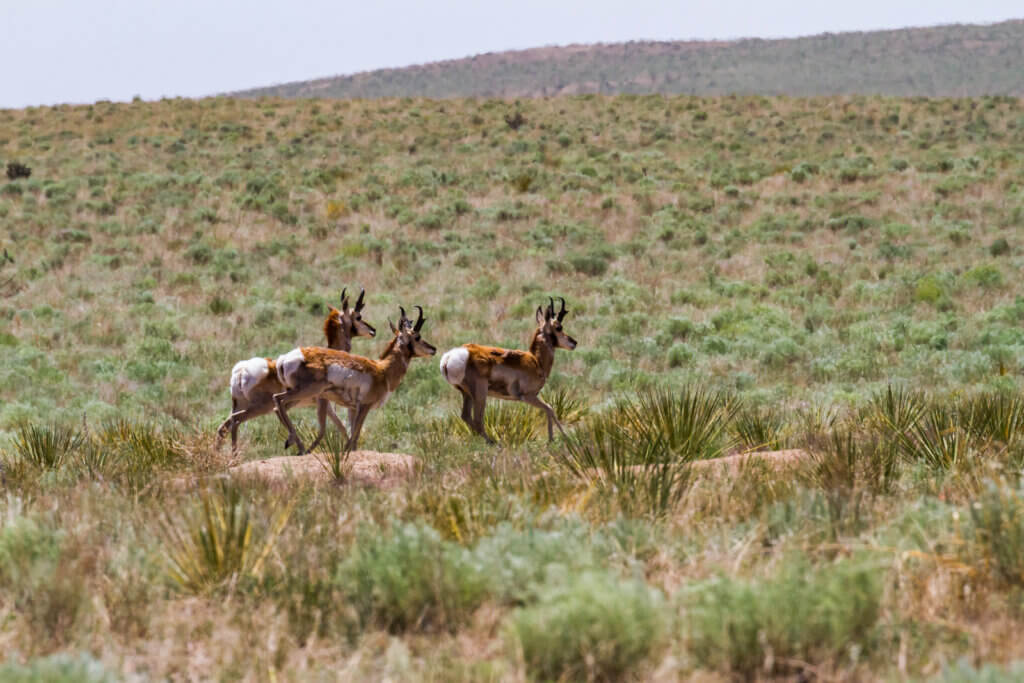Speed on the Prairie
By Shane Morrison
Broadcast 8.9 & 8.12.2023

The speedsters of the plains, pronghorn are the fastest land animal in North America. Photo © Shane Morrison.
Listen:
When doing field work, I drive the dirt roads that stretch for miles across the grasslands. I drive slowly as the roads are rutted and rough and cross open cattle range. I often spot pronghorn running in the distance. A creature of wide-open spaces, the pronghorn ranges across the glaciated plains of Montana: a varied country of sagebrush steppes, coulees, broken hills, and rolling mixed-grass prairie that stretches as far as the eye can see.
Usually, pronghorn will dash away when they see a truck coming. However, at times I’ve had them actually race toward me, accelerating, seemingly intent on crossing the road ahead of me. With incredible speed, they invariably pass well ahead of the truck and speed on by. There’s no contest, as they are much faster than my truck over rough ground.
As I thought about this, I wondered just how fast pronghorn are. I found that pronghorn have been clocked at speeds of up to 62 miles per hour over a half-mile. Also incredible, they can sustain a speed of 35 miles per hour for over five miles. They are the fastest land animal in the Western Hemisphere.
I had assumed the fastest land animals were in Africa, a land of open savannahs, teeming with many species of antelope chased by several large, fast predators. And I was partly correct. The two fastest antelopes are in Africa: the springbok and the sassaby, clocked at 55 and 56 miles per hour, respectively. The fastest land animal bar none is the African cheetah, with a top speed of 65-76 miles per hour over a quarter mile. Surprisingly, the American pronghorn, not an African antelope, is considered the second-fastest animal in the world, and probably the fastest over long distances.
How is the pronghorn so fast? Compared to what would be expected based on its body size, the pronghorn has extra-light bones. Their hooves and ankles are designed to absorb the shock of such speed. And they have an extra-large heart, windpipe, and lungs that can take in large amounts of oxygen while running. The pronghorn is optimized for speed.
This optimization, which evolved over millennia, implies that the pronghorn probably coevolved with one or more predators. Predator and prey are intimately connected in a life-and-death struggle, locked together in an evolutionary dance. But who was the predator?
This was puzzling as there is no extant North American predator fast enough to drive such evolutionary adaptations. Research provided a likely answer. I was excited to find that the pronghorn shared the American savannah during the Pleistocene with large grassland predators, the American lion and American cheetah. The American cheetah and lion were morphologically similar to their modern African counterparts, only larger. Scientists have postulated that, faced with such predators, the pronghorn had to evolve its incredible speed to survive. But then, at the end of the last ice age,12,000 years ago, these predators became extinct.
One November day, I led a field trip traveling in two vehicles. Driving home, a large band of pronghorn sped up to overtake us. I held my speed as they surged past and swung across the road perhaps 75 feet ahead. I was surprised when, instead of turning away from us, the lead pronghorn swerved back across the road again. The band followed, racing, full speed, leaning into each turn, swerving repeatedly across the road before finally turning away.
I gazed across the prairie to see pronghorn racing the wind alone, as if compelled, as if pursued by a phantom, a predator that last roamed the Pleistocene prairie twelve millennia ago, born from some deep genetic memory.
Every week since 1991, Field Notes has inquired about Montana’s natural history. Field Notes are written by naturalists, students, and listeners about the puzzle-tree bark, eagle talons, woolly aphids, and giant puffballs of Western, Central and Southwestern Montana and aired weekly on Montana Public Radio.
Click here to read and listen to more Field Notes. Field Notes is available as a podcast! Subscribe on Apple Podcasts or wherever you listen to podcasts.
Interested in writing a Field Note? Contact Allison De Jong, Field Notes editor, at adejong [at] montananaturalist [dot] org or 406.327.0405.
Want to learn more about our programs as well as fun natural history facts and seasonal phenology? Sign up for our e-newsletter! You can also become a member and get discounts on our programs as well as free reciprocal admission to 300+ science centers in North America!












